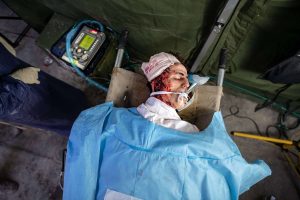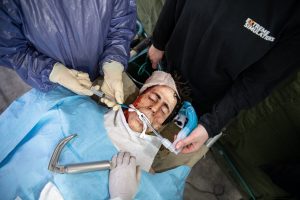Disaster recovery for rescue forces is a real necessity in every country, so how do you prepare for such a scenario?
The Beirut mega-disaster reminded us once again how important it is that medical and rescue forces are prepared to manage disaster recovery in extreme events.
Disaster recovery principles for rescue forces
One of the characteristics of mega-disasters is the damage caused to the emergency infrastructure: rescue workers are injured, hospitals’ staff are affected, the infrastructure suffers serious destruction, evacuation routes are blocked, vital factories are hit, and the list can continue.
This is what happened in Beirut.
- Firefighters who came in large numbers to deal with the fire were hit by the massive explosion.
- The main hospital was damaged as a result of the explosion and it was partially disabled.
- Lack of readiness, beyond the heavy cost of human life, created a lack of trust in leadership, resulting in instability.
Had the city prepared for a similar scenario in advance, a multitude of these unfortunate events would have been avoided or at least managed better.
How can emergency organizations, municipalities, and states be prepared for disaster recovery?
Several principles for preserving the efficiency of emergency infrastructure are summarized for you below. These are implemented around the world and help special forces to prepare for disastrous situations.

1st disaster recovery principle: Plan in advance
Too often we see organizations responsible for managing disastrous events taken by surprise when an extreme event occurs. They are supposed to be prepared especially for this kind of situation, so why does this happen?
Emergency management institutions are often stuck in a “routine coma” that doesn’t challenge their teams to improve or to even realize the impact of an extreme event. The thought that “it won’t happen to me” is another deal-breaker, so much so that, when a disaster occurs, these teams find themselves incapable of coming up with a rescue plan.
The first step in preparing for disaster recovery is to accept that it will happen to you and you need to be ready for whatever comes your way.
Train for all possible scenarios, but especially for those scenarios where you or your team members are injured and incapable of conducting a rescue mission by the book.
2nd disaster recovery principle: “Don’t put all your eggs in one basket”
Emergency management institutions must map organizational bottlenecks. Know your strengths, but know your weaknesses better, so ask yourself: do you have the right rescue equipment? What about inventory? Medicine? Manpower?
After analyzing these potential bottlenecks, divide and save: ensure that they are stored in different places. During an extreme event, some of these places might be out of reach, so you want to make sure that at least some of them are accessible.
For example, a hospital where we performed extreme events training was dependent on one sterilization facility. Without that facility, operating became impossible. In the training scenario, this facility was supposedly hit and destroyed, which immediately caused chaos in the entire hospital.
Conclusion? As a disaster recovery organization, you must map all your organizational bottlenecks. The hospital had to identify them and learn how to overcome them in the case of a crisis situation. In this case, it had to assess whether the doctors could operate outside of the emergency rooms, in car parks or dining rooms, and be logistically prepared for that.

3rd disaster recovery principle: Avoid the “30-hour phenomenon”
Disaster strikes. You are faced with an emergency like no other you’ve experienced so far.
You assess the situation, come up with a plan, evaluate your resources, and establish your needs.
What do you do next?
Reserve preservation.
You have no idea what complications might arise on the way. You know nothing about how long the event/rescue mission/disaster recovery will last. So you need to ensure that you hold on to your resources for as much as possible.
It is tempting for everyone to run ahead and provide care by the book without thinking about what might happen next. It is understandable: you were taught to save lives by using all the available resources.
But what happens during an extreme event is that everyone acts vigorously at first. There is a lot of adrenaline involved. No one knows how long the rescue mission will last, so they go on and on and on without taking a break. After 30 hours, everyone collapses in burnout.
What do you do then?
Another scenario that we’d like you to imagine is the following: following an extreme incident several crew members are injured. There is no significant mobile force to rescue them.
What do you do then?
Useful tip: Reserve preservation. Use resources wisely, come up with a backup plan, and don’t go into burnout.

4th disaster recovery principle: A trained chain of command
The ability to manage an extreme event relies heavily on the person in charge. It is only normal that you will invest significant efforts in the training and coaching of our executive managers and commanders.
However, experience taught us that, in major disasters, commanders and executive managers might be harmed, remain disconnected or that communication systems might be damaged in a way that requires junior managers to make meaningful decisions.
Vice-mangers and unprepared deputies will have a hard time doing this without prior preparation. As it usually does, this will happen at the least appropriate moments.
For this reason, deputies should also be trained and prepared for emergency situations. Sharing knowledge and empowering the deputy managers on a routine basis can improve the outcome of a disaster recovery mission.

5th disaster recovery principle: Volunteers and non-dedicated resources
It is impossible for any organization to set up and maintain entire human resources for an extreme situation. The immense costs that such a procedure implies make this scenario impossible.
Therefore, most institutions make use of volunteers. These people have far less training than a disaster recovery team, but they can help in rescue missions, supply management, etc.
The good news about volunteers is that there are numerous civilians whose daily profession proves useful in an emergency. They just need to be trained and prepared in advance for such scenarios.

Observation: for this purpose, volunteers should be recruited on weekdays and trained periodically.
Useful tip: Civilian tools for disaster management should be mapped and volunteers should know their exact location and means of use (cranes, drilling tools, water and salt tanks, refrigerated trucks, and more).
Civilian volunteers ensure that the mission is managed properly and by numerous people. This way you will have access to important human resources that can prove vital in case the rescue personnel is affected.
6th disaster recovery principle: Mobility
Napoleon won wars thanks to his ability to bring great power at the right time to the right place.
Rapid mobility of forces, medical equipment, blood packets, means of rescue are vital.

7th disaster recovery principle: Cooperation
Collaboration and common language between organizations and cities will enable you to function when personnel and infrastructure are hit. They enable the preservation of forces for long periods of time (see principle number 3 above).
In mega-disasters, the ability to back each other up is crucial.
When looking at real extreme events, and from what we see in the exercises we provide, absorbing help is done with great difficulty. From demarcation of boundaries to interfaces, command, procedures, language, bureaucratic and legal issues, to issues like sleep and food for outsourced forces, all these need to be planned and agreed upon in advance and practiced regularly

8th disaster recovery principle: Hands-on training
Everything we have talked about so far will not work without training.
Extreme events management doesn’t work in real life without simulating disasters in a physical and real way. Not just in tabletop games.
Each training should be thoroughly researched and produce meaningful learning that will form the basis of a practical and effective work plan.
Train your team for disaster recovery now
GET IN TOUCH
Contact Extreme Simulations now to book a complete training session





